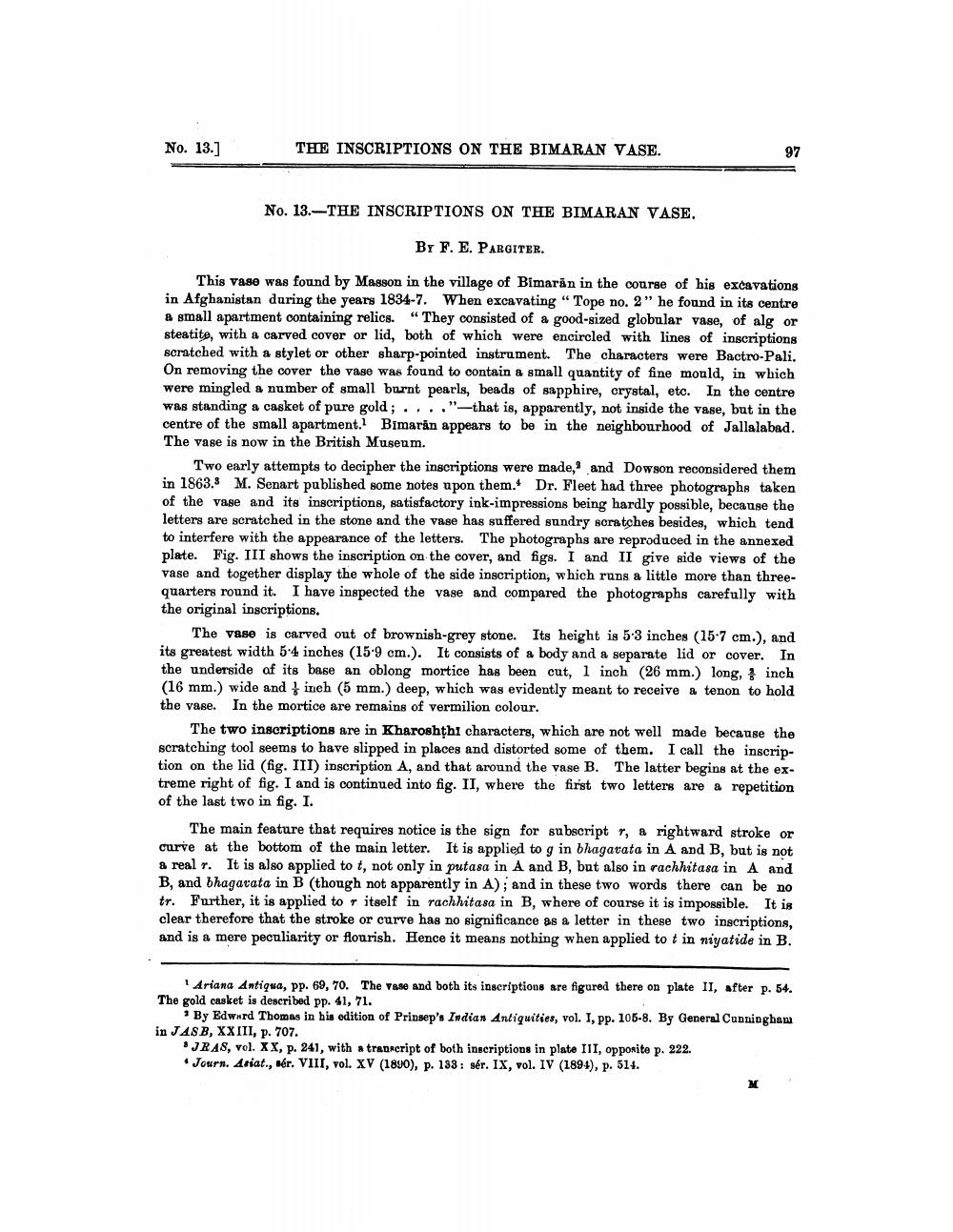________________
No. 13.]
THE INSCRIPTIONS ON THE BIMARAN VASE.
No. 13.-THE INSCRIPTIONS ON THE BIMARAN VASE.
BY F. E. PARGITER.
This vase was found by Masson in the village of Bimaran in the course of his excavations in Afghanistan during the years 1834-7. When excavating “ Tope no. 2" he found in its centre a small apartment containing relics. “They consisted of a good-sized globular vase, of algor steatite, with a carved cover or lid, both of which were encircled with lines of inscriptions scratched with a stylet or other sharp-pointed instrument. The characters were Bactro-Pali. On removing the cover the vase was found to contain a small quantity of fine mould, in which were mingled a number of small burnt pearls, beads of sapphire, crystal, etc. In the centre was standing a casket of pure gold; ...."—that is, apparently, not inside the vase, but in the centre of the small apartment. Bimarán appears to be in the neighbourhood of Jallalabad. The vase is now in the British Museum.
Two early attempts to decipher the inscriptions were made, and Dowson reconsidered them in 1863.8 M. Senart published some notes upon them. Dr. Fleet had three photographs taken of the vase and its inscriptions, satisfactory ink-impressions being hardly possible, because the letters are scratched in the stone and the vase has suffered sundry scratches besides, which tend to interfere with the appearance of the letters. The photographs are reproduced in the annexed plate. Fig. III shows the inscription on the cover, and figs. I and II give side views of the vase and together display the whole of the side inscription, which runs a little more than threequarters round it. I have inspected the vage and compared the photographs carefully with the original inscriptions.
The vase is carved out of brownish-grey stone. Its height is 5-3 inches (15-7 cm.), and its greatest width 5-4 inches (15-9 cm.). It consists of a body and a separate lid or cover. In the underside of its base an oblong mortice has been cut, 1 inch (26 mm.) long, inch (16 mm.) wide and ineh (5 mm.) deep, which was evidently meant to receive a tenon to hold the vase. In the mortice are remains of vermilion colour.
The two inscriptions are in Kharoshthi characters, which are not well made because the scratching tool seems to have slipped in places and distorted some of them. I call the inscription on the lid (fig. III) inscription A, and that around the vase B. The latter begins at the extreme right of fig. I and is continued into fig. II, where the first two letters are a repetition of the last two in fig. I.
The main feature that requires notice is the sign for subscript T, a rightward stroke or curve at the bottom of the main letter. It is applied to g in bhagatata in A and B, but is not a real t. It is also applied to t, not only in putasa in A and B, but also in rachhitasa in A and B, and bhagavata in B (though not apparently in A); and in these two words there can be no tr. Further, it is applied to itself in rachhitasa in B, where of course it is impossible. It is clear therefore that the stroke or curve has no significance as a letter in these two inscriptions, and is a mere peculiarity or flourish. Hence it means nothing when applied to t in niyatide in B.
Ariana Antiqua, pp. 69, 70. The Vase and both its inscriptions are figured there on plate II, after p. 54. The gold casket is described pp. 41, 71.
* By Edward Thomas in his edition of Prinsep's Indian Antiquities, vol. I, pp. 105-8. By General Cunningham in JASB, XXIII, p. 707.
JRAS, vol. XX, p. 241, with a transcript of both inscriptions in plate III, opposite p. 222. • Journ. Asiat., sér. VIII, vol. XV (1890), p. 133: sér. IX, vol. IV (1894), p. 514.




